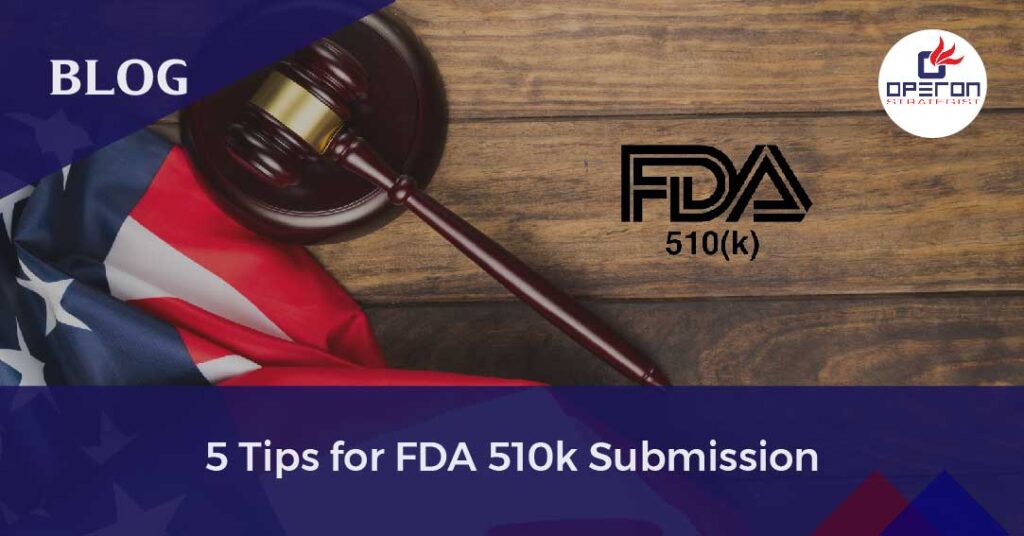Expert Guidance for FDA 510(k) Submission
Are you creating a medical device and requesting FDA approval to enter the market?
Navigating the FDA 510(k) application process can be intimidating, so do not worry! We’ve prepared five crucial pointers in this blog post to assist you in effectively completing and submitting your FDA 510(k). These helpful tips are intended to speed up your submission, improve your chances of being approved, and guarantee adherence to FDA regulations. We’ve also provided a helpful checklist to walk you through the procedure. So, let’s get started and bring your medical device closer to improving patient care!
Streamline FDA 510(k) Submission with Operon Strategist
Tips for FDA 510(k) Submission
- Leverage the RTA Checklist for a Smooth Submission:
A well-organized FDA 510(k) submission is vital in securing clearance for your medical device. To assist you in this process, the FDA has provided 510k submission checklist.
This checklist provides you with the essential elements and requirements your 510k submission must meet. Utilizing the RTA checklist ensures your application is comprehensive and aligns with the FDA’s expectations.
It is essential to provide clear and specific information while filling out your FDA, citing the relevant sections within your 510(k) submission. It makes it easier for FDA reviewers to locate critical information. Moreover, the checklist serves as a quality control tool, ensuring that your submission meets all necessary criteria before undergoing the review process. - Complete Comprehensive Testing Before Submission:
You all need to agree on this statement that, “Thorough testing is the backbone of any successful FDA 510(k) submission.” To gain FDA clearance, you must show that your medical device is safe, effective, and performs as intended. Critical tests include sterilization validation, biocompatibility assessments, and electrical safety testing.
Sterilization validation makes sure that your device is free from harmful microorganisms that could pose a risk to patients. Biocompatibility assessments confirm that your device’s materials are compatible with the human body and won’t cause adverse reactions. Electrical safety testing verifies that your device operates safely, without electrical hazards.
Prioritizing comprehensive testing and including detailed protocols, results, and reports in your submission will strengthen it and speed up the review process. Well-documented testing is valued by FDA reviewers as it gives them the data, based on which they judge the efficacy and safety of your medical device. - Include Detailed Test Protocols, Data & Results:
Presenting comprehensive data is essential in an FDA 510(k) submission. The FDA’s expectations have evolved, and they now require more than just test summaries. Instead, they seek complete performance test protocols, raw data, and in-depth results.
By including all this information, you demonstrate the scientific validity of your testing processes and strengthen the credibility of your medical device. In addition, comprehensive data allows FDA reviewers to thoroughly evaluate your device’s performance, safety, and effectiveness, leading to a more expedited review process. - Strive for Similarity with Predicate Devices:
The cornerstone of the FDA 510(k) application procedure is substantial equivalence. Your medical product must be essentially interchangeable with a predicate product that is currently authorized for legal marketing in the US. By proving this similarity, you may make sure that your device’s effectiveness and safety can be inferred from the prior approval of the predicate device.
It is crucial to perform a comprehensive comparison with the predicate device. In this analysis, the design, materials, performance, and intended usage are all evaluated. You align your device with the predicate’s indications, contraindications, precautions, and warnings to show that they are substantially equivalent.
It’s important to strike a balance between similarity and differentiation. - Anticipate and Understand FDA Questions:
Despite how well-prepared your submission is, FDA reviewers may have questions during the review process. This is a standard part of the FDA clearance process and should not be cause for concern. Instead, consider these inquiries an opportunity to thoroughly explain your device’s effectiveness and safety.
When FDA inquiries arise, respond promptly and professionally. Seek clarification if necessary and ensure that your responses are thorough and supported by data.
Need More Clarity on the Submission Process of 510(k)?
Be aware that FDA 510(k) submissions usually take a minimum of six months for clearance, possibly longer. It’s essential to plan accordingly and allow sufficient time for the submission and review process.
Access personalized support of Operon Strategist to guide you through each step of the submission process. Our consultants bring in-depth knowledge to enhance your chances of approval.
Contact us now Leave the complexities. Our team specializes in 510(k) Consultation, granting you peace of mind as we strive to secure FDA clearance for your medical innovation.
- adminhttps://operonstrategist.com/author/admin-2/
- adminhttps://operonstrategist.com/author/admin-2/
- adminhttps://operonstrategist.com/author/admin-2/
- adminhttps://operonstrategist.com/author/admin-2/




